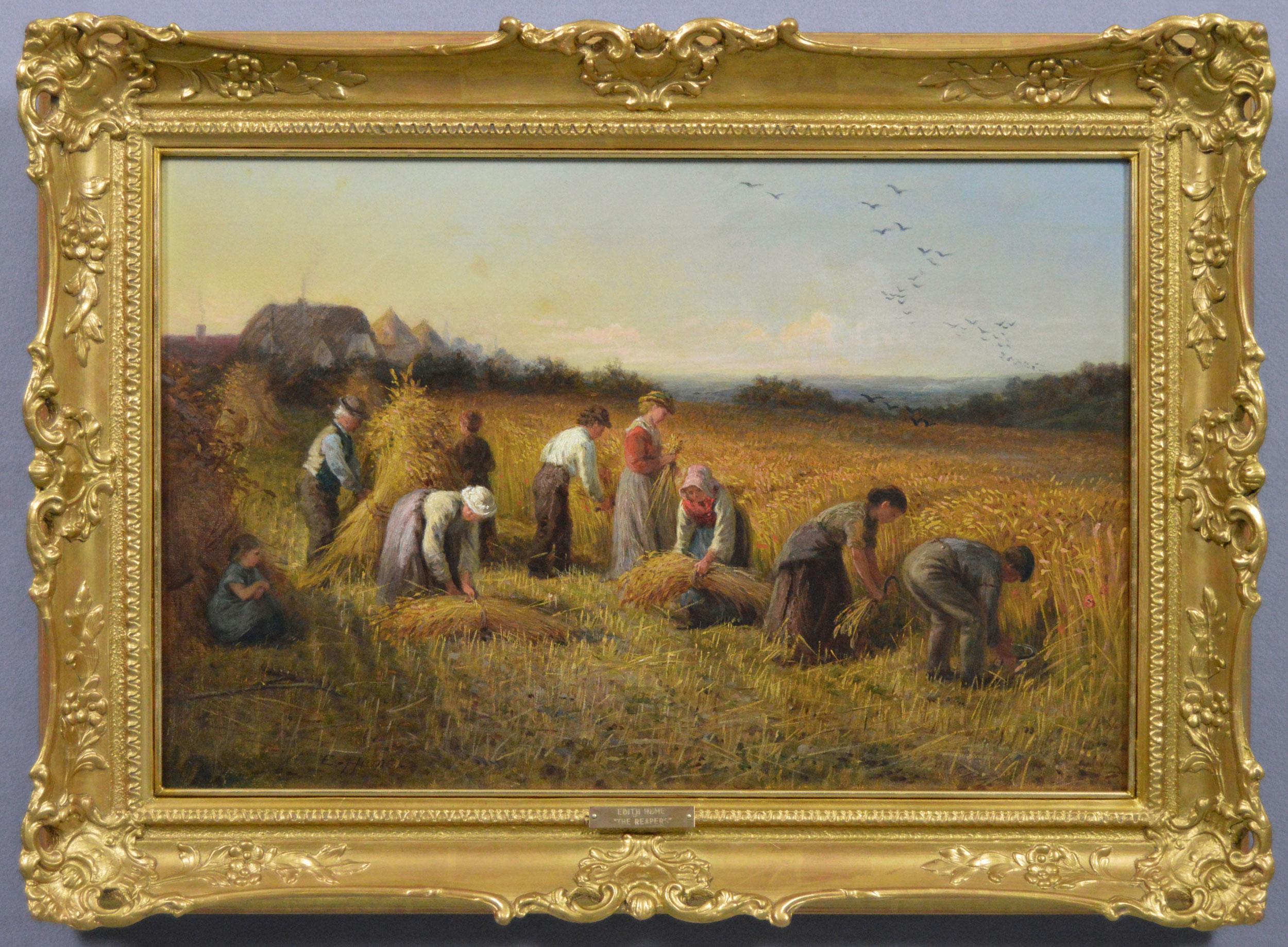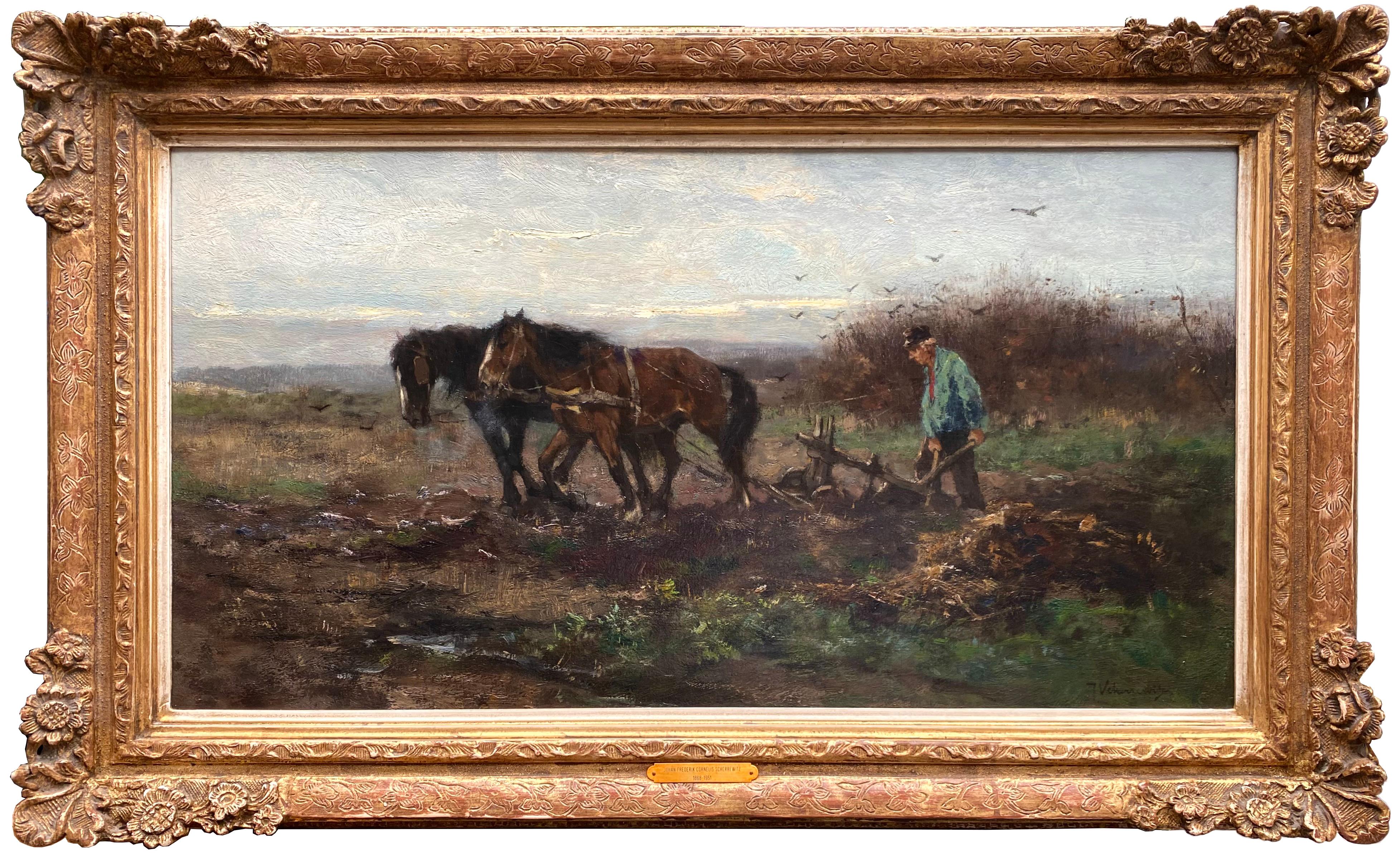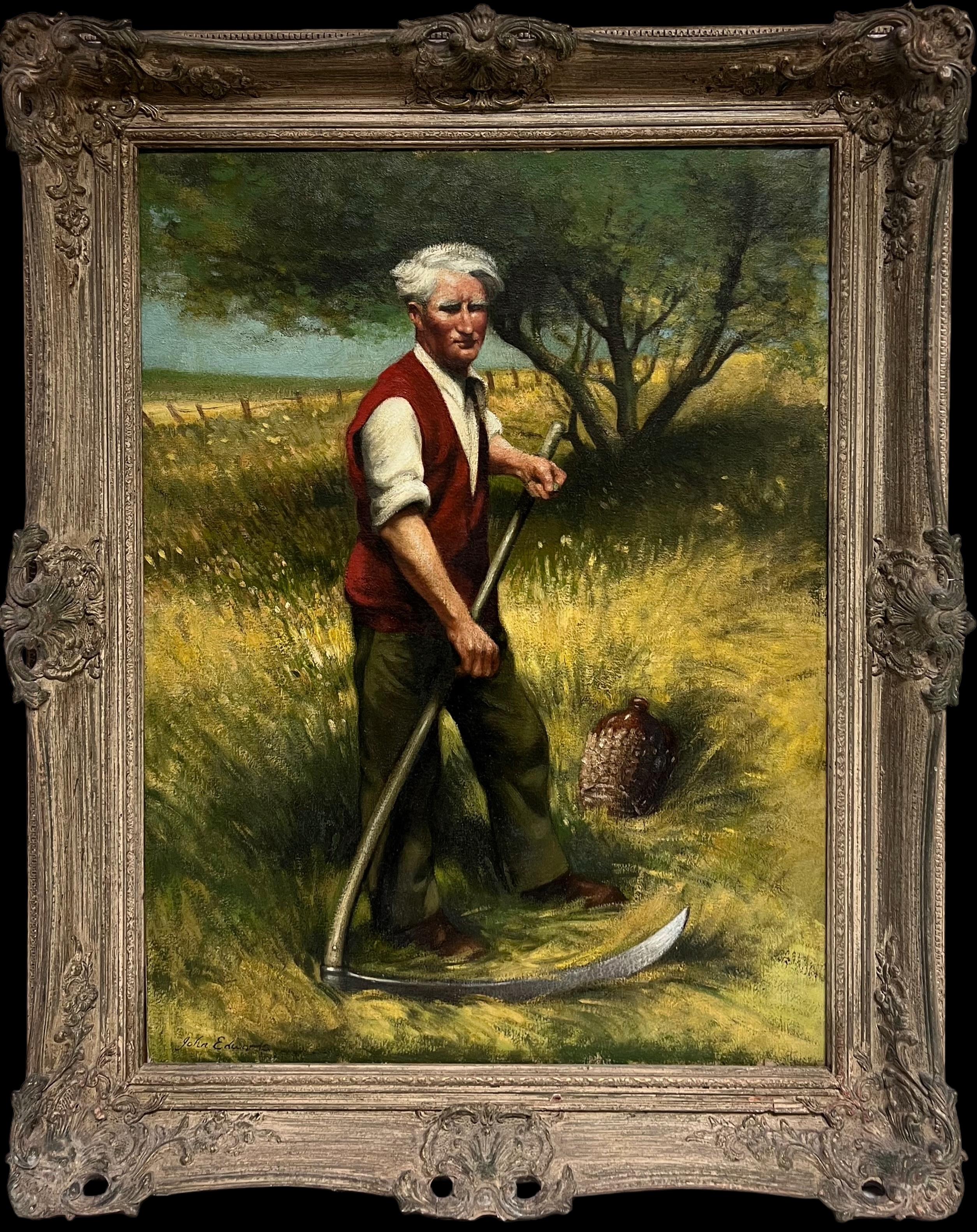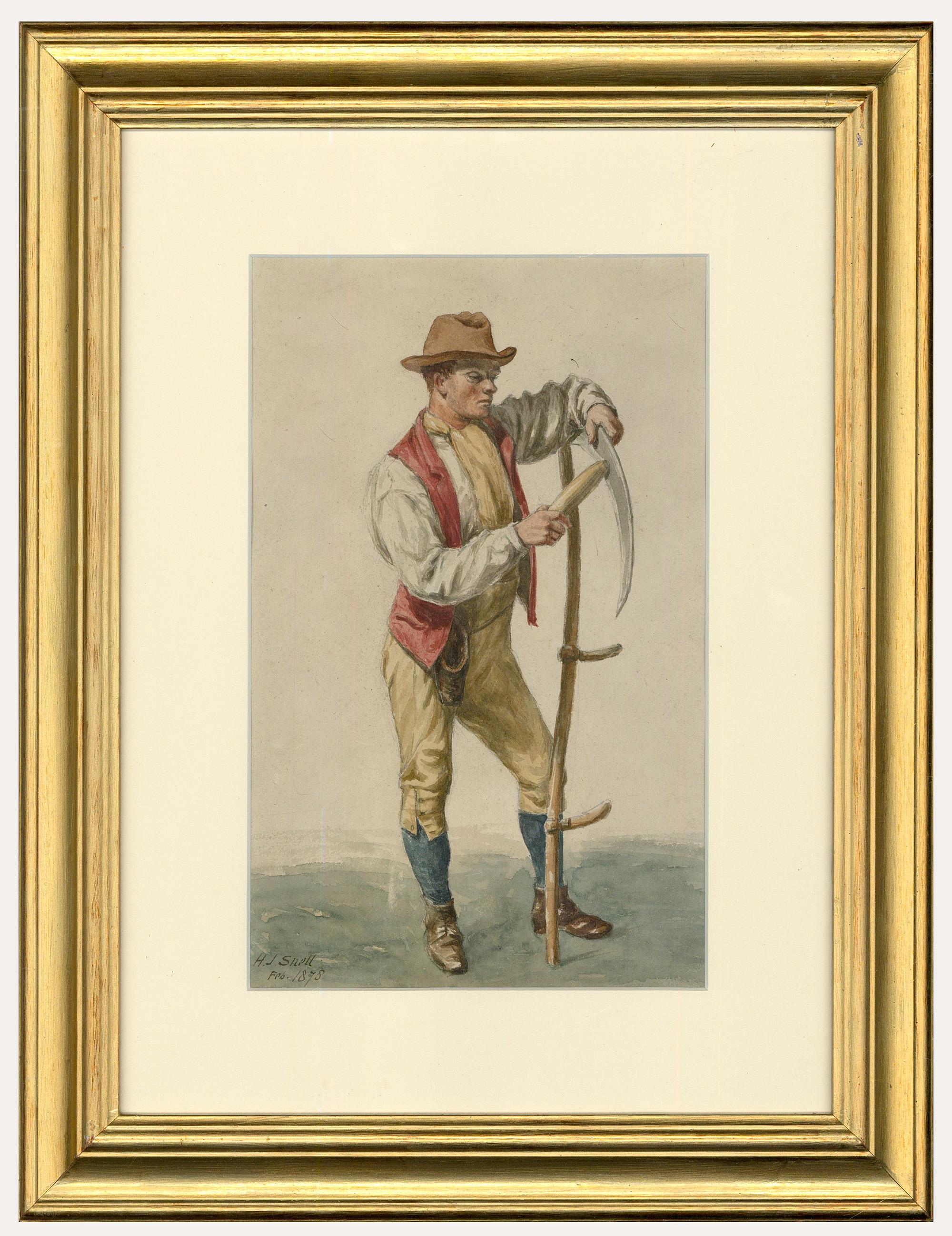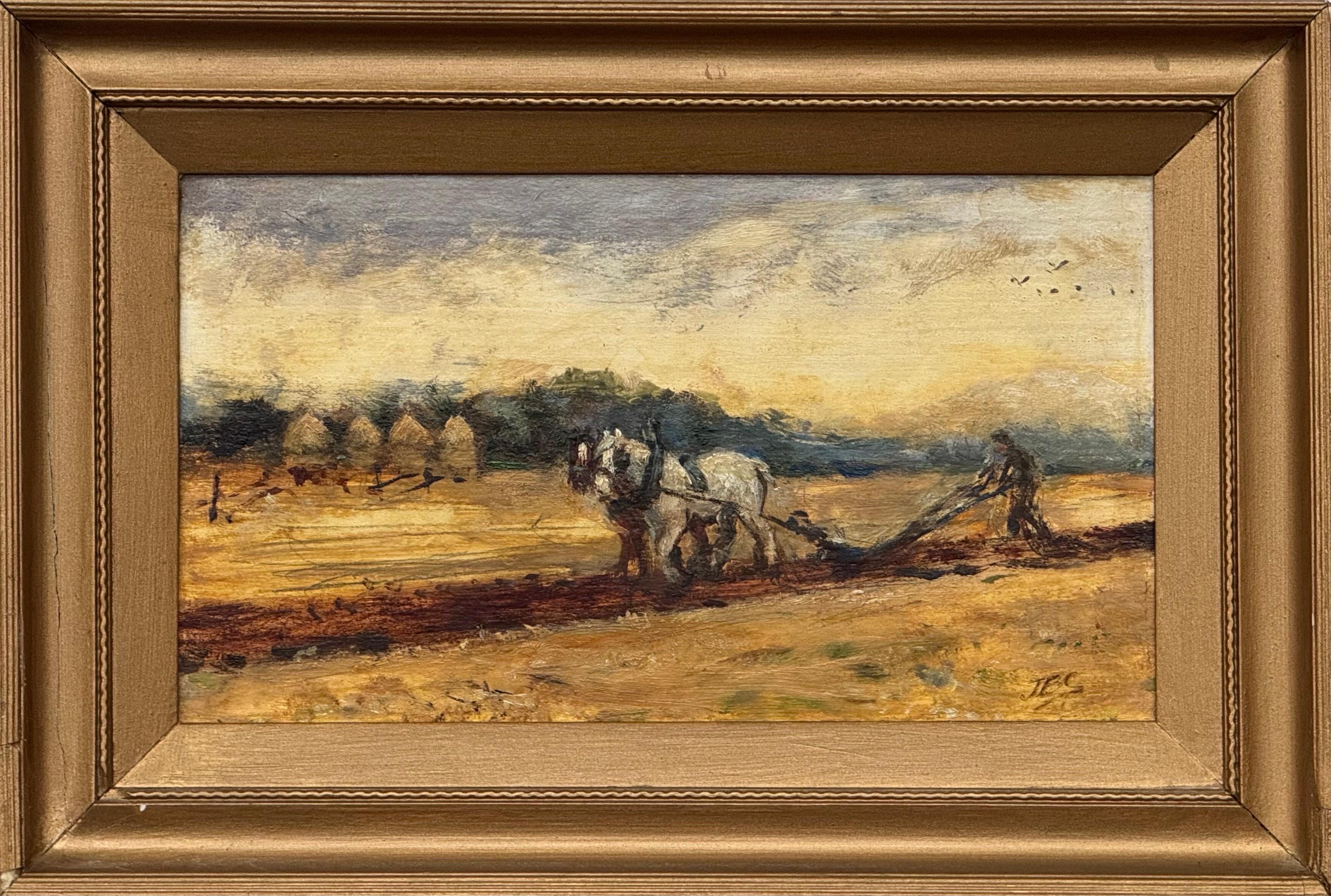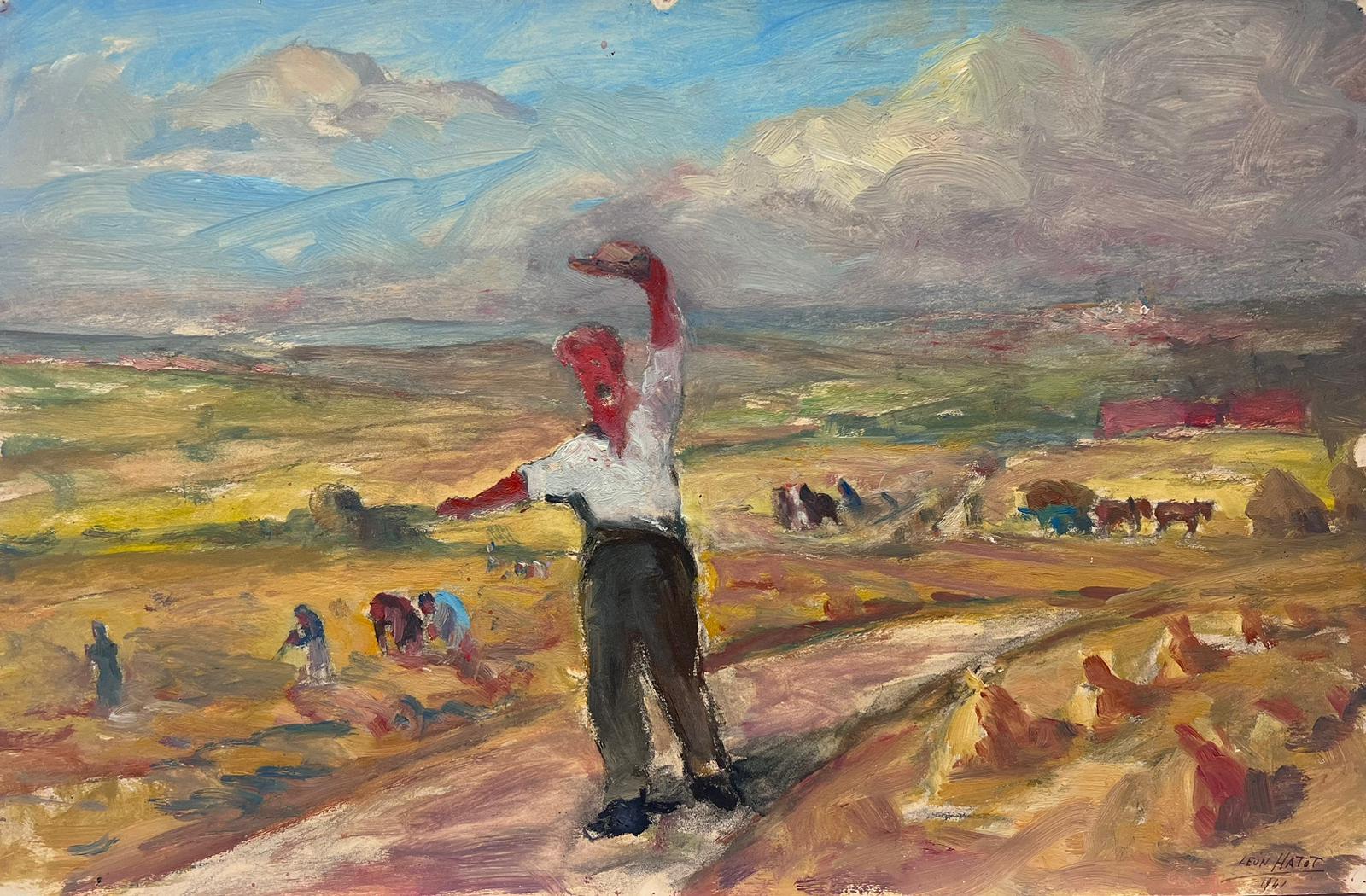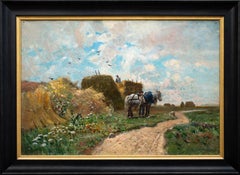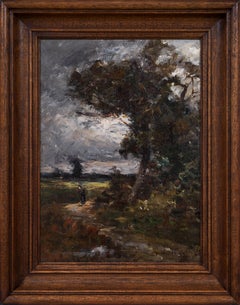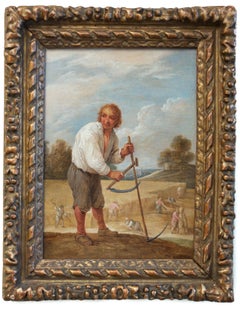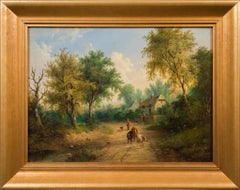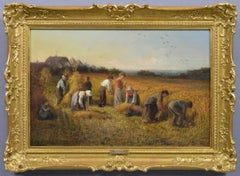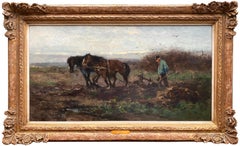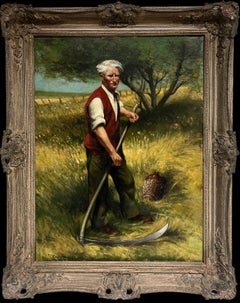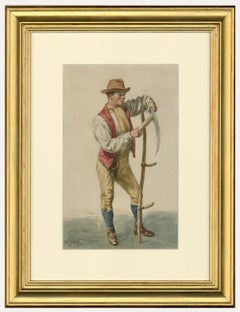Items Similar to Harvest Scene With Farmer and Scythe, 1886
Want more images or videos?
Request additional images or videos from the seller
1 of 9
Alfred ThörneHarvest Scene With Farmer and Scythe, 18861886
1886
$3,437.79
£2,574.64
€2,900
CA$4,818.92
A$5,309.33
CHF 2,748.43
MX$63,925.67
NOK 34,801.76
SEK 32,694.05
DKK 22,087.10
About the Item
"Harvest Scene With Farmer and Scythe, 1886" is a captivating painting by the Swedish artist Alfred Thörne. Created during his travels through Germany, France, Italy, and Belgium between 1884 and 1886, this artwork reflects the artist's keen observation of rural life and his skill in capturing the essence of human labor.
The painting portrays a farmer in the midst of his daily work, bending over with a scythe in hand, cutting through the tall grass. The composition is intimate, focusing on the solitary figure of the man, who is dressed in typical work attire of the period: a white vest over a long-sleeved shirt and dark trousers. His posture suggests a moment of deep concentration and effort, a testament to the hard work and dedication of those who work the land.
The background of the painting is subtly rendered, with soft hues that do not distract from the central figure, allowing the viewer to fully appreciate the farmer's form and the texture of the grass. The light is diffused, giving the scene a tranquil yet serious atmosphere, which may indicate the early morning or late afternoon—the prime times for such labor.
Artist's Background: Alfred Thörne was born on April 24, 1850, in Horn, Östergötland, Sweden, and passed away on March 15, 1916, in Stockholm. He was the son of shoemaker Sven Petter Thörne and Inga Catrina Nilsdotter. Thörne studied under Per Daniel Holm at the Royal Swedish Academy of Fine Arts in Stockholm from 1874 to 1880, where he earned the royal medal in 1880 for his painting "Sommarmorgon."
Thörne became an agré (associate member) of the academy in 1881, and in 1884, he received a travel scholarship that allowed him to study in Germany, France, Italy, and Belgium. His works were exhibited in various prestigious venues, including the Stockholm exhibitions with Olof Hermelin in 1910, the Nordic Art and Industrial Exhibition in Copenhagen in 1888, and the World's Columbian Exposition in Chicago in 1893. His public works include an altarpiece for Vimmerby Church and numerous landscapes and portraits.
Thörne’s paintings is held in several Swedish museums, including the Nordic Museum, Nationalmuseum, Östergötlands Museum, Norrköpings Art Museum, Gävle Museum, and Sundsvall Museum.
oil on canvas
signed and dated Alf Thorne 1886
unframed 43.5 x 28.5 cm
framed 63 x 48 cm
- Creator:Alfred Thörne (1850 - 1916, Swedish)
- Creation Year:1886
- Dimensions:Height: 24.81 in (63 cm)Width: 18.9 in (48 cm)
- Medium:
- Movement & Style:
- Period:
- Condition:Very good condition. The painting is newly cleaned, The frame is very beautiful, with some old patina and minor flaws.
- Gallery Location:Stockholm, SE
- Reference Number:1stDibs: LU1445215036882
About the Seller
5.0
Platinum Seller
Premium sellers with a 4.7+ rating and 24-hour response times
Established in 2020
1stDibs seller since 2020
204 sales on 1stDibs
Typical response time: <1 hour
Associations
International Confederation of Art and Antique Dealers' Associations
- ShippingRetrieving quote...Shipping from: Stockholm, Sweden
- Return Policy
Authenticity Guarantee
In the unlikely event there’s an issue with an item’s authenticity, contact us within 1 year for a full refund. DetailsMoney-Back Guarantee
If your item is not as described, is damaged in transit, or does not arrive, contact us within 7 days for a full refund. Details24-Hour Cancellation
You have a 24-hour grace period in which to reconsider your purchase, with no questions asked.Vetted Professional Sellers
Our world-class sellers must adhere to strict standards for service and quality, maintaining the integrity of our listings.Price-Match Guarantee
If you find that a seller listed the same item for a lower price elsewhere, we’ll match it.Trusted Global Delivery
Our best-in-class carrier network provides specialized shipping options worldwide, including custom delivery.More From This Seller
View AllHarvest Time by Hjalmar Sandberg, Swedish Artist, Oil on Canvas, Signed, 1876
Located in Stockholm, SE
Hjalmar Sandberg (1847-1888) Sweden
Harvest Time, 1876
oil on canvas
canvas size 14.96 x 18.11 inches (38 x 46 cm)
frame 18.70 x 25.59 inches (47.5 ...
Category
1870s Impressionist Landscape Paintings
Materials
Canvas, Oil
French Moonlit Landscape with Brushwood Gatherer (1872)
Located in Stockholm, SE
Under a softly luminous night sky, an elderly peasant gathers a bundle of brushwood amid the quiet fields of rural France. This tranquil nocturne is the subject of Alfred Wahlberg’s ...
Category
1870s Impressionist Figurative Paintings
Materials
Oil, Wood Panel
Peasants in a Cornfield (Boer in het veld) by David Teniers the Younger
By David Teniers the Younger
Located in Stockholm, SE
Remembering the magic of everyday life moments in the art of David Teniers:
The art of David Teniers the Younger (1610–1690) coincided with the heyday of the Flemish Baroque and captured a great variety of motifs of his time. In this painting of a seemingly simple peasant scene lies keys to understanding both the imaginative mind of Teniers as well as why this time period produced some of the most iconic works in all of art history.
As indicated by the name, Teniers was more or less born into his profession. As the son of David Teniers the elder, himself a painter who studied under Rubens, the younger David received training in art from a very young age and had no less than three brothers who also became painters. Because of his father’s frequent financial failures that even at times saw him imprisoned, David the younger helped to rescue the family from ruin through painting copies of old masters. Essentially, the young Teniers was confronted with painting as both a passion and creative expression as well as a necessity during difficult times, an experience that would shape much of his capacity and sensitivity in his coming life.
Despite the hardships, the talent and determination of Teniers was recognized and quickly expanded his possibilities. He had already spent time in France and possibly also England when he was hired by his father’s former teacher Rubens to help with a prestigious commission with mythological paintings, now considered lost, for Philip IV the king Spain. In 1644–54 Teniers was appointed dean of the Antwerp Guild of Saint Luke, manifesting his esteemed position within the artistic community. A few years afterwards he took an important step when relocating to Brussels, where Teniers yet again found new career opportunities that would prove to be very successful.
As the keeper of the collections of Archduke Leopold Wilhelm, a role similar to what we now refer to as an art advisor, Teniers purchased hundreds of important artworks that manifested the prominent status of the Archduke’s collection while at the same time providing an unusual access to inspiration and knowledge for Teniers himself. Since he kept on painting during the same time, his creative scope must have seemed almost bewildering in the great variety of images and stories that he surrounded himself with.
Regardless of how glamorous and culturally stimulating the career of Teniers was, he was as open to the charm and existential importance of everyday life as he was to works of great masters and luxurious collectibles. In his impressive repertoire of genres with everything from exquisite royal portraits, interiors, landscapes and history paintings he always added something new and inventive, highlighting the possibilities of art and importance of an experimental and intuitive mind. It is difficult to single out one aspect or genre to summarize his legacy, since it lies much more in the broad virtuosity across many motifs, although he is particularly remembered for farm scenes and meticulously depicted interiors where other paintings and artworks are captured with an astonishing precision. However, the fact that he is still today one of the most known and celebrated names of the Dutch Golden Age is a proof to the magic of his work, which continues to spark dialogue and wonder in the contemporary viewer of his works.
The farm boy in the field in this painting, which likely dates to the mature part of his career, is a wonderful entry into the mind of Teniers. In the tightly cropped motif, we see him standing right in the middle of the busy harvest when men, women and everyone capable were sent out in the field to collect the crop that formed the very core of their diet and survival. In the background we see a fresh blue sky interspersed with skillfully painted clouds, some trees reaching their autumnal colours and in the far distance the glimpse of a small church and village. The presence of a church in a landscape, so typical of Dutch art, served both a symbolic and visual function as a representation of faith while at the same time defining scale and distance.
In the field, the work is in full action with the farmers spread out in various positions, all in the midst of hard and sweaty labour. While they are portrayed as having nothing else than the work on their mind, our farm boy seems to have his attention directed elsewhere. Standing there with his white, half open shirt, flowy curls and strong, sturdy body; his gaze is directed away, out of the picture and the scythes in his hands. He looks almost smirking, expressed with tremendous subtlety in the slight smile of his lips and big eyes, being just in the middle of losing focus on the work. What is it that steals his attention? What has he seen, or realized, or felt – to break him free of the arduous task of harvesting, if but for a moment?
Here starts the wondering and the questions that are the hallmark of a great piece of art. Instead of explicitly locking in the motif in overly clear symbolism Teniers has chosen an open ended, subtle yet striking moment for us to consider. While it of course can be related to numerous other farm scene depictions of this time, and clever usages of gazes and real-life scenes to underscore various moral or symbolic meanings, the painting can be much more of a contemplation than an explanation or illustration. The ordinary nature and understated yet emotionally textured composition of the motif gives greater space for our own reactions and thoughts. Has he seen a pretty farm girl just passing by? Is he fed up with the farm life, joyously dreaming away for a minute, imagining another future? Or is he simply in need of distraction, looking away and ready for anything that can steal his attention?
One quality that never seem to have escaped Teniers was that of curiosity. During all of his career he constantly investigated, expanded and experimented with not only the style and technique of painting, but with the vision of art itself. Being credited with more or less introducing farm motifs for a broader audience not only tells us of his ability to understand the demand for different motifs, but the sensitivity to transform seemingly ordinary parts of life into deep aesthetic experiences, far beyond their expected reach. The farm boy in this painting is, of course, exactly that. But with the help of one smirk the entire picture is charged with a different energy, awakening many contrasts and relationships between the calm landscape, the hard work and his own breach of effectivity, holding sharp scythes while thinking or seeing something else.
It is no wonder Teniers chose to work with farm scenes as a way of investigating these intricate and delicate plays on expectations and surprises, clarity and ambivalence. It invites us to an appreciation of human everyday life that connects us with the people of 17th century...
Category
Late 17th Century Old Masters Landscape Paintings
Materials
Canvas, Oil
The Daily Tasks of Rural Life, c. 1860, Romanticism Oil Painting.
Located in Stockholm, SE
This serene landscape painting is by James Howe Carse, a Scottish-Australian artist whose lineage and mentorship are deeply rooted in the artistic traditions of his time. Carse's wor...
Category
Mid-19th Century Romantic Figurative Paintings
Materials
Canvas, Oil
Original Oil Painting Depicting a Farmstead in Dalarna, Sweden, 1864
Located in Stockholm, SE
Olof Arborelius (1842–1915) Sweden
Farmstead in Dalarna, 1864
signed with monogram OA and dated “Arb-s 64” inscribed into the wet paint, with the estate’s stamp "OA" on the back.
o...
Category
1860s Impressionist Landscape Paintings
Materials
Oil, Board, Laid Paper
A Day in the Countryside by Henry John Yeend King
By Henry John Yeend King
Located in Stockholm, SE
This delightful painting by the renowned Victorian genre and landscape artist Henry John Yeend King captures the serene charm of the English countryside. Depicting an idyllic riversi...
Category
Late 19th Century Romantic Landscape Paintings
Materials
Canvas, Oil
$3,467 Sale Price
25% Off
You May Also Like
19th Century landscape oil painting of harvesters gathering wheat
Located in Nr Broadway, Worcestershire
Edith Hume
British, (1841-1913)
The Reapers
Oil on canvas, signed
Image size: 15.25 inches x 23.25 inches
Size including frame: 21.5 inches x 29.5 inches
Provenance: Sotheby’s Vict...
Category
Late 19th Century Victorian Landscape Paintings
Materials
Canvas, Oil
'Spring Ploughing with Two Horses' by Johan Scherrewitz (1868 – 1951)
Located in Knokke, BE
Johan Frederik Cornelis Scherrewitz
Amsterdam 1868 – 1951 Hilversum
Dutch Painter
'Spring Ploughing with Two Horses'
Signature: signed lower right 'J. Scherrewitz'
Medium: oil on c...
Category
Early 19th Century Romantic Landscape Paintings
Materials
Canvas, Oil
Traditional Rural English Signed Oil Painting Hay Cutting Portrait with Scythe
Located in Cirencester, Gloucestershire
Hay Cutting
by John Edwards (English, 1940 - 2020)
signed oil on canvas, framed
framed: 29 x 23.5 inches
canvas : 23 x 18 inches
Provenance: private collection, UK
Condition: very go...
Category
Mid-20th Century Victorian Portrait Paintings
Materials
Oil
H.J. Snell - English School 1878 Watercolour, Farmer with a Scythe
Located in Corsham, GB
A wonderful portrait of a young farmer or labourer standing with a scythe. He wears a colourful red waistcoat with blue socks and yellow scarf. Well presented in a gilt effect frame....
Category
Late 19th Century Portrait Drawings and Watercolors
Materials
Watercolor
$276 Sale Price
20% Off
Horses Ploughing Field with Farmer in the English Countryside by British Artist
Located in Preston, GB
Horses Ploughing Field with Farmer in the English Countryside by British Artist, a miniature vintage oil painting
Art measures 9.5 x 5.5 inches
Frame measures 12 x 8.5 inches
Frame...
Category
Mid-20th Century English School Animal Paintings
Materials
Oil, Board
Vintage French Oil Painting Farmer in Harvest Fields Golden Light Landscape
Located in Cirencester, Gloucestershire
Artist/ School: Leon Hatot (French 1883-1953)
Title: Impressionist oil painting
Medium: signed oil painting on thick paper, stuck on board unframed
dated 1941
Size: painting: 13...
Category
Early 20th Century Impressionist Landscape Paintings
Materials
Oil
